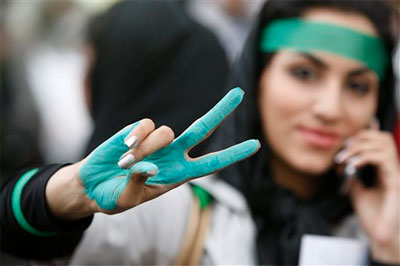After about two and a half years during which the danger of war between the United States and Iran was at a relatively low level, this threat is now rapidly increasing. A pattern of political and diplomatic events, military deployments, and media chatter now indicates that Anglo-American ruling circles, acting through the troubled Obama administration, are currently gearing up for a campaign of bombing against Iran, combined with special forces incursions designed to stir up rebellions among the non-Persian nationalities of the Islamic Republic. Naturally, the probability of a new fake Gulf of Tonkin incident or false flag terror attack staged by the Anglo-American war party and attributed to Iran or its proxies is also growing rapidly.
 | |
| The failure of the CIA’s Green Movement in Iran gives rise to the tendency to fall back on the previous neocon plan for some combination of direct military attack by Israel and the United States. | |
The moment in the recent past when the US came closest to attacking Iran was August-September 2007, at about the time of the major Israeli bombing raid on Syria.1 This was the phase during which the Cheney faction in effect hijacked a fully loaded B-52 bomber equipped with six nuclear-armed cruise missiles, and attempted to take it to the Middle East outside of the command and control of the Pentagon, presumably to be used in a colossal provocation designed by the private rogue network for which Cheney was the visible face. A few days before the B-52 escaped control of legally constituted US authorities, a group of antiwar activists issued The Kennebunkport Warning of August 24-25, 2007, which had been drafted by the present writer.2 It was very significant that US institutional forces acted at that time to prevent the rogue B-52 from proceeding on its way towards the Middle East. The refusal to let the rogue B-52 take off reflected a growing consensus in the US military-intelligence community and the ruling elite in general that the Bush-Cheney-neocon policy of direct military aggression towards all comers had become counterproductive and very dangerous, running the risk of a terminal case of imperial overstretch.
A prominent spokesman for the growing disaffection with the neocons was Zbigniew Brzezinski, who had been a national security director in the Carter administration. Brzezinski argued that no more direct military attacks by the United States should be made for the time being, and that US policy should rather focus on playing off other states against each other, while the US remained somewhat aloof. Brzezinski’s model was always his own successful playing of the Soviet Union against Afghanistan in 1979, leading to the collapse of the Soviet empire a decade later. A centerpiece of Brzezinski’s argument was evidently the claim that color revolutions on the model of Ukraine 2004 were much a better tool than the costly and dangerous US bombing and US invasion always championed by the monomaniacal neocons. There was clearly an implication that Brzezinski could deliver a color revolution in Iran, as he had done in Ukraine.

No comments:
Post a Comment